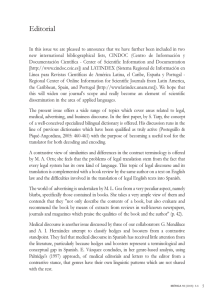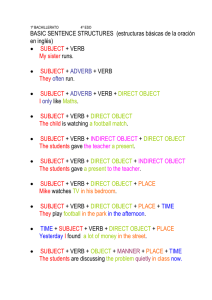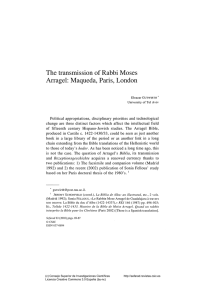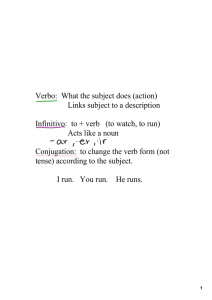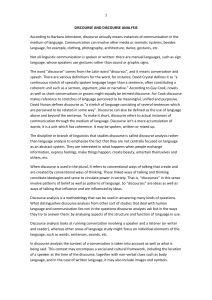Text in context: a textual-linguistic approach to - Sefarad
Anuncio
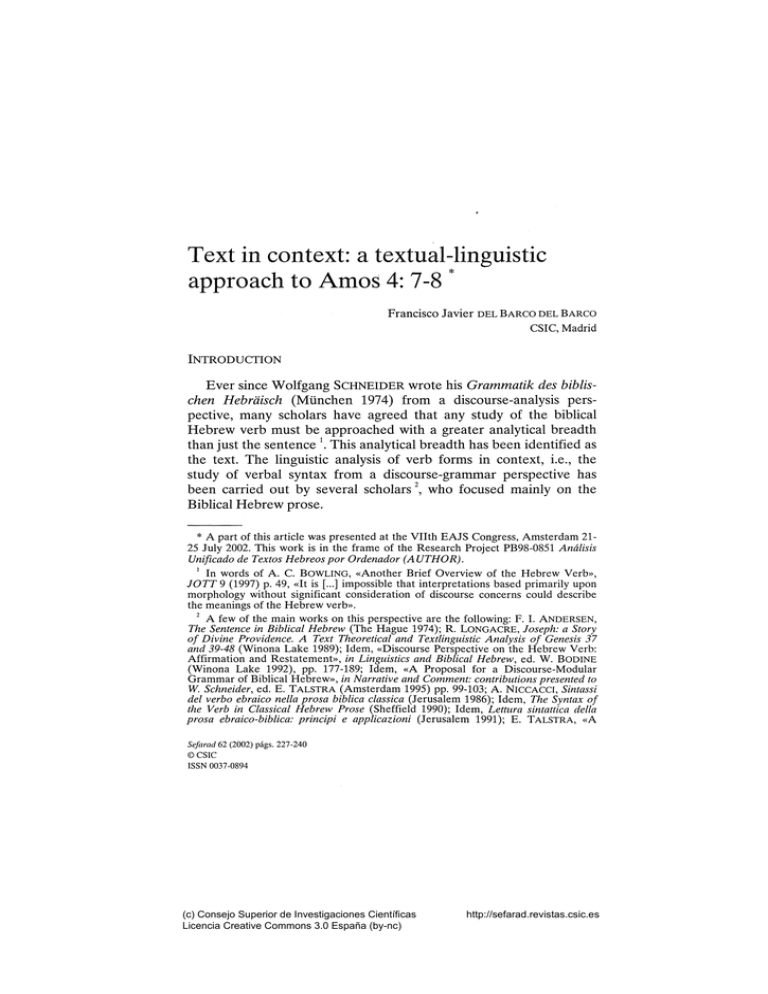
Text in context: a textual-linguistic
approach to Amos 4: 7-8 *
Francisco Javier DEL BARCO DEL BARCO
CSIC, Madrid
INTRODUCTION
Ever since Wolfgang SCHNEIDER wrote his Grammatik des biblischen Hebraisch (München 1974) from a discourse-analysis perspective, many scholars have agreed that any study of the biblical
Hebrew verb must be approached with a greater analytical breadth
than just the sentence ^ This analytical breadth has been identified as
the text. The linguistic analysis of verb forms in context, i.e., the
study of verbal syntax from a discourse-grammar perspective has
been carried out by several scholars ^ who focused mainly on the
Biblical Hebrew prose.
* A part of this article was presented at the Vllth EAJS Congress, Amsterdam 2125 July 2002. This work is in the frame of the Research Project PB98-0851 Análisis
Unificado de Textos Hebreos por Ordenador (AUTHOR).
^ In words of A. C. BOWLING, «Another Brief Overview of the Hebrew Verb»,
JOTT 9 (1997) p. 49, «It is [...] impossible that interpretations based primarily upon
morphology without significant consideration of discourse concerns could describe
the meanings of the Hebrew verb».
A few of the main works on this perspective are the following: F. I. ANDERSEN,
The Sentence in Biblical Hebrew (The Hague 1974); R. LONG ACRE, Joseph: a Story
of Divine Providence. A Text Theoretical and Textlinguistic Analysis of Genesis 37
and 39-48 (Winona Lake 1989); Idem, «Discourse Perspective on the Hebrew Verb:
Affirmation and Restatement», in Linguistics and Biblical Hebrew, ed. W. BODINE
(Winona Lake 1992), pp. 177-189; Idem, «A Proposal for a Discourse-Modular
Grammar of Biblical Hebrew», in Narrative and Comment: contributions presented to
W. Schneider, ed. E. TALSTRA (Amsterdam 1995) pp. 99-103; A. NiCCACCI, Sintassi
del verbo ebraico nella prosa biblica classica (Jerusalem 1986); Idem, The Syntax of
the Verb in Classical Hebrew Prose (Sheffield 1990); Idem, Lettura sintattica della
prosa ebraico-biblica: principi e applicazioni (Jerusalem 1991); E. TALSTRA, «A
Sefarad 62 (2002) págs. 227-240
©CSIC
ISSN 0037-0894
(c) Consejo Superior de Investigaciones Científicas
Licencia Creative Commons 3.0 España (by-nc)
http://sefarad.revistas.csic.es
228
FRANCISCO JAVIER DEL BARCO DEL BARCO
5e/62:2 (2002)
Robert LONGACRE ^ identified different kinds of discourse depending on the speaker's linguistic intention, i.e., depending on the
speaker's communication goals. This involves a different pattern of
verb form usage in each type of discourse. According to Longacre's
theory, the main discourse types found in prose are: narrative discourse, predictive discourse, procedural or instructional discourse,
hortatory or persuasive discourse, expository discourse, and juridical
discourse.
We will first see some of the kinds of discourse that can be found
in prophetic texts, in order to understand the syntactic structures and
the verb forms involved in each one of them, with examples taken
directly from prophetic books. I will then analyse Amos 4:7-8 from a
texthnguistic approach within the structure of the chapter in which it
is inserted.
Such an analysis is needed because the set of verb forms used
seems to be different from the rest of the verb forms used in the
chapter. Differences between the two sets of verb forms used in
Amos 4:7-8 are not usually noted in the translations, as we will see in
many of the most important bibhcal translations to European
languages.
TYPES OF DISCOURSE
In Longacre's own words, «narrative discourse tells a story about
particular people and their actions and contingencies in past time» ^
This means that narrative discourse is past oriented. A chain of
wayyiqtol forms expresses the main line of communication, or
foreground, while background actions would be expressed using
qatal with no fronted element, and using qatal or yiqtol with a
fronted element. In the first case, the syntactic structure is displayed
as verb-x, while in the second, as x-verb, being x any nominal fronted
element. When they are inserted in a wayyiqtol chain, the differences
of use among qatal-x, x-qatal, x-yiqtol and participle clauses would be
Hierarchically Structured Data Base of Biblical Hebrew Texts», in Actes du 1er
Colloque International Bible et Informatique: le texte. Louvaine la Neuve, septembre
1985 (Paris - Genève 1986) pp. 335-349; Idem, «Hebrew Syntax: Clause Types and
Clause Hierarchy», in Studies in Hebrew and Aramaic Syntax presented to Professor
J. Hoftijzer, eds. K. JONGELING et al. (Leiden 1991) pp. 180-193.
«Discourse Perspective».
R. LONGACRE, «Discourse Perspective», p. 178.
(c) Consejo Superior de Investigaciones Científicas
Licencia Creative Commons 3.0 España (by-nc)
http://sefarad.revistas.csic.es
5e/62:2 (2002)
229
TEXT IN CONTEXT: A TEXTUAL-LINGUISTIC.
one of aspect: qatal-x expresses preparatory or resultant actions, xqatal expresses punctual background actions, and x-yiqtol and
participle clauses express durative or repetitive actions.
Although not commonly used, narrative discourse is found here
and there in prophecy. A good example is Amos 2:9-12, inserted in
the oracle against Israel, the last of the oracles against the nations
reported in chapters 1 and 2 of Amos. Here, God stresses Israel's
past sins despite God's favors regarding Israel. The section is
reported as the reason for Israel's future punishment that the
prophet announces ^
gW-x^-qataf-x^
p-NC'
[p-]NC
wayyiqtol^-x^
[wayyiqtol^-]x^
jgW-x'-qatal^-x"
wayyiqtol'-x^
p-cons.inf.-x
D"':I1VK3 Kin
A-
-IT
v
fom
ly
T :
:nnrip v;pip)
Dn^^p xim npm 'n'^^'^n 'p^Kiio
jjWayyiqtol'-x^
[wayyiqtol^-]x^
p-NC
F
j2 wayyiqtol^-x
w-x-qatal^-inf.
N-yiqtof
u'k'iù
Dp-'np •7^<^1I
n\inb Dpn^napi
:nin^-DKJ
]•''' ani-in-nx ipt2^nii2
The Hebrew text of the examples is from Biblia Hebraica Stuttgartensia [BHS]
(Stuttgart 1977). Translations of the texts are from New Revised Standard Version of
the Bible [NRSV] (Oxford 1989), unless otherwise indicated. In every example, the
Hebrew text, in the right side, is accompanied by the syntactic structure of the
clauses, in the left side. Abbreviations and symbols used are: 0 = no element, w =
waw, p = particle, x = nominal element, NC = nominal clause, F = (prophetic)
formula, N = negative particle, Q = time reference, part. = participle, (cons.)inf. =
(construct) infinitive, cohor. = cohortative. A number in superscript indicates the
person of the verb or the person of the pronominal reference in a nominal element.
Brackets indicate verb gapping.
(c) Consejo Superior de Investigaciones Científicas
Licencia Creative Commons 3.0 España (by-nc)
http://sefarad.revistas.csic.es
230
FRANCISCO JAVIER DEL BARCO DEL BARCO
Sef 62:2 (2002)
«(9) Yet I destroyed the Amerite before them, whose height was hke the
height of cedars, and who was as strong as oaks; I destroyed his fruit above,
and his roots beneath. (10) Also I brought you up out of the land of Egypt,
and led you forty years in the wilderness, to possess the land of the Amorite.
(11) And I raised up some of your children to be prophets and some of your
youths to be nazirites. Is it not indeed so, O people of Israel? says the Lord.
(12) But you made the nazirites drink wine, and commanded the prophets,
saying, 'You shall not prophesy.'»
Note the use of the chain of wayyiqtol as the main line of
communication, and the use of qatal with a fronted element as
backgrounded actions. Regarding time, verse 10 is not sequential to
verse 9; on the contrary, the event reported in verse 10 is prior to that
reported in verse 9:
(10) First event in time: «Also I brought you up out of the land of Egypt,
and led you forty years in the wilderness, to possess the land of the
Amorite».
(9) Second event in time: «Yet I destroyed the Amorite before them,
whose height was like the height of cedars, and who was as strong as oaks; I
destroyed his fruit above, and his roots beneath».
Predictive discourse is, as Longacre says, «a story told in advance
of its happening» ^ Predictive discourse is, therefore, future oriented.
The main line of communication is made up using a weqatal chain,
which expresses future events in the same way that a wayyiqtol chain
expresses past events. When punctual actions or focus must be
expressed, a yiqtol clause with a fronted element is used, and if the
clause has a negative particle before the verb, a yiqtol clause is used
again instead weqatal.
Regarding prophetic texts, predictive discourse is common.
Prophets talk about future events completely convinced that they are
going to happen. Thus, they described the future consequences of
past sins and the future restoration of Israel's glory using predictive
discourse. One of several examples of predictive discourse in preexihc Minor Prophets is Micah 5:9-14:
R. LONGACRE, «Proposal», p. 100.
(c) Consejo Superior de Investigaciones Científicas
Licencia Creative Commons 3.0 España (by-nc)
http://sefarad.revistas.csic.es
Se/62:2 (2002)
çWehayah -Q
F
weqatal^-x^
weqatal^-x^
^^weqatal^-x^
weqatal^-x^
jjWeqatal^-x^
w-x-N-yiqtof-x^
j^weqatal^-x^
w-N-yiqtof-x^
j3weqatal'-x^
weqatal^-x^
j^weqatal^-x
p-N-qataf
231
TEXT IN CONTEXT: A TEXTUAL-LINGUISTIC .
-
I IV T s
Kv T •
If T
I IV -r
y
^:i- !
\-
: I•
vr
I -
•
T
T
:
! -IT
V
y
-
y
yv-n-
<r T : -^
:
V :
:
•
!
• ! * ^
r
: I
i
:
«(9) In that day, says the Lord, I will cut off your horses from among you
and will destroy your chariots; (10) and I will cut off the cities of your land
and throw down all your strongholds; (11) and I will cut off sorceries from
your hand and you shall have no more soothsayers; (12) and I will cut off
your images and your pillars from among you, and you shall bow down no
more to the work of your hands; (13) and I will uproot your sacred poles
from among you and destroy your towns. (14) And in anger and wrath I will
execute vengeance on the nations that did not obey.»
A construction with wehayah plus a future time reference is
widely used to introduce predictive discourse in biblical prophecy.
Note that all weqatal forms are in the T^ p.s. but not the two yiqtol
clauses. These two clauses are negative, so the use of a weqatal form
would be impossible. The same can be said about the qatal clause,
introduced by the relative ^aser. As in this example, predictive
discourse is future oriented.
Hortatory or persuasive discourse «is characteristic of the human
situation in which one person tries to impose his or her will on
another person» \ Thus imperatives, cohortatives and jussives make
R. LONGACRE, «Discourse Perspective», p. 186.
(c) Consejo Superior de Investigaciones Científicas
Licencia Creative Commons 3.0 España (by-nc)
http://sefarad.revistas.csic.es
232
FRANCISCO JAVIER DEL BARCO DEL BARCO
Sef 62:2 (2002)
Up this kind of discourse. Negative clauses with the particle ^al are
used for negative commands. Typical of this kind of discourse is the
so-called modal imperfect. Longacre explains that a persuasive
discourse may show a mitigation of the imperatives which typically
characterize it. This mitigation consists of using weqatal forms after
one or two initial imperatives.
Hortatory or persuasive discourse is an important kind of discourse in prophetic texts. Direct address and commands from God,
or the prophet, to the people are not uncommon. Hosea 14:2-4a is an
example of hortatory discourse:
^O-qtolV
^'sp^ r]}r]] \^ bkitp: nnits?^
p-qataf-x'
'^^¡m i^X?^? '?
30-qtol'-x'
a^^i?? D??? in¡73
w-qtol'-x
O-qtol'-x'
x-yiqtof-x
w-qtol'-x
^2^r^^ ^^^P)
Vb^ \^r?^
fij? K^r\-b3
nio-n¡?i
w-cohor.'-x^
,x-N-yiqtof'
x-N-yiqtol'
w-N-yiqtol'-x'
-^^'ri??^ ^'^^ ^J?ÍPí^
^^TP"^' i<> I ^\m4
n?:!? K> 0^0"^J7
"^^'X ^P'S^)^ 1^\D^Î? '^'^.? ^^K^'^^)
«(2) Return, O Israel, to the Lord your God, for you have stumbled because
of your iniquity. (3) Take words with you and return to the Lord; say to him:
-Take away all guilt; accept that which is good, and we will offer the fruit of
our lips. (4) Assyria shall not save us; we will not ride upon horses; we will
say no more 'Our God' to the work of our hands».
Imperatives make up the main line of communication, introducing
direct speech. This direct speech is developed with an imperative, a
cohortative, and some yiqtol forms. Note that V and 2"^* personal
references are widely used. This is typical in hortatory discourse.
Note also that two of the yiqtol forms in verse 4 are in the 1'* person.
Although they do not have the final -h of the distinctive cohortative,
they bear a vohtive function equivalent to that of the distinctive
cohortative.
(c) Consejo Superior de Investigaciones Científicas
Licencia Creative Commons 3.0 España (by-nc)
http://sefarad.revistas.csic.es
5e/62:2 (2002)
233
TEXT IN CONTEXT: A TEXTUAL-LINGUISTIC.
Another kind of discourse is the expository discourse. Here,
nominal clauses and participle clauses bear the main line of communication. Some yiqtol or qatal clauses can be inserted in the discourse, but as a secondary explanation of some specific point of the
exposition. Descriptions and static elements are basic in the
expository discourse. Some texts belonging to this type of discourse
can be found in chapter 2 of Habakkuk:
,p-part.-x
w-part.-x^ [...]
^p-part.-x'
MVlb VI 572S2 J72S3 ^iHg
ill? Dn^3 mtûb
p-cons.inf.-x^
p-cons.inf.-x [...]
j,p-part.-x
I-
T -
<
T
[...] tj/n-sisD
biìnb
a''Dì2 TV nil
''lni2
A•
T
:
^
yv
-J
1 ^
w-part.-x [...]
j3P-part.-x'
O-part.-x^
w-p-cons.inf
^nJ7n njp^p ^lni5
p-cons.inf.-x^ [...]
i9P-part.-x
0-qtol
0-qtol
n > np'K ^lni9
[part.-]x
«(6) Alas for you who heap up what is not your own! How long will you load
yourselves with goods taken in pledge? [...] (9) Alas for you who get evil
gain for your houses, setting your nest on high to be safe from the reach of
harm! [...] (12) Alas for you who build a town by bloodshed, and found a city
of iniquity! [...] (15) Alas for you who make your neighbors drink, pouring
out your wrath until they are drunk, in order to gaze on their nakedness! [...]
(19) Alas for you who say to the wood, 'Wake up!' to silent stone, 'Rouse
yourself!'»
The structure of this passage is based on the participle clauses
which describe the people who are the object of the lamentation. The
repetitive use of the particle hoy conveys the idea of lamentation.
Thus, the structure of hoy plus participle constitutes an expository
(c) Consejo Superior de Investigaciones Científicas
Licencia Creative Commons 3.0 España (by-nc)
http://sefarad.revistas.csic.es
234
FRANCISCO JAVIER DEL BARCO DEL BARCO
Se/62:2 (2002)
discourse in which other kinds of discourse are inserted. These
insertions are represented with brackets in the text of the example.
As the particle hoy • is so important for this typical expository
discourse in prophecy, I would prefer to call it lamentation discourse.
The examples shown above demonstrate that the specific purpose
of communication is relevant to the syntactic structure of a text and
plays a basic role in choosing verb forms that are to be used in the
text. Among the different kinds of discourse that we have just
reviewed, two of them involve the use of the so-called consecutive
forms as the main line of communication: weqatal in predictive
discourse and wayyiqtol in narrative discourse. This fact must be
taken into account in the following analysis of the text in Amos 4:7-8.
VERB FORMS IN A M O S 4:7-8
As we have noted before, in this section of the book of Amos the
set of verb forms used seems to be different from the rest of the verb
forms used in the same chapter. Verses 7 and 8 constitute, altogether
with verses 6, 9, 10 and 11, a description of God's past punishments
to Israel so that the israehtes would regret their sins and turn back to
God. But ttie Israelites did not turn back to God, and this is
proclaimed by the prophet at the end of each reported punishment
with the sentence :nin''-DK:i •'157 Dmti^'K'Vl.
Each one of verses 6, 9, 10, 11 express one different past
punishment suffered by the Israelites:
^w-x^ataf-x"
Dbn_^-VD3 D^i?? \\y}
D5^
''Jiri3 '''3K"D?16
w-[x'-qatal^-]x'
°?'?^PV? X^? °P^ ^ÇP)
w-N-qataf-x^
-^J^rû^^ \?? m^i^^'K^^I
«(6) I gave you cleanness of teeth in all your cities, and lack of bread in all
your places, yet you did not return to me, says the Lord».
^0-qatal^-x'
11¡7T.?i PP??^? S p ^ ^ '^''^^^9
0-x^-yiqtof-x
^P''?'??) ^P'^Ti^?^ nlànn
w-N-qataf-x'
-nj^r^i? \^? Q|^?Í?^'K'^)
(c) Consejo Superior de Investigaciones Científicas
Licencia Creative Commons 3.0 España (by-nc)
http://sefarad.revistas.csic.es
5e/62:2 (2002)
TEXT IN CONTEXT: A TEXTUAL-LINGUISTIC .,
235
«(9) I struck you with Wight and mildew; I laid waste your gardens and your
vineyards; the locust devoured your fig trees and your olive trees; yet you
did not return to me, says the Lord».
^,0-qatalV
0-qatal^-x^
wayyiqtol^-x^
w-N-qatalV
n:b}P WÌ
^?? °?? '•Hni'^^io
Q.?"'!?^^ '?P ^^ ^P^T^P^ ^^^O? '^W
°^?i??.^ Qp'ÎpÇi K^^ ^}W¡
tmn^-DKrn^? a j i r K ' ^ i
«(10) I sent among you a pestilence after the manner of Egypt; I killed your
young men with the sword; I carried away your horses; and I made the
stench of your camp go up into your nostrils; yet you did not return to me,
says the Lord».
^jO-qatal'-x^
Í*^P""^?^ ^'^^'^.^ ^P?nD3 Dpn ''iiDSHn
wayyiqtof-x
^.^'^fP ^J!? "^l^? ^'Ç^í^l
w-N-qataf-x^
-^.3^:"°?? \^? ^íií^'K"^)
«(11) I overthrew some of you, as when God overthrew Sodom and
Gomorrah, and you were like a brand snatched from the fire; yet you did not
return to me, says the Lord».
In terms of the verb forms used, it is clear that these verses are
past oriented in time. Qatal in the first position of its clause is used
not only in the prophet's proclamation at the end of each one of the
punishments reported, but also at the beginning of verses 9, 10 and
11. In verses 10 and 11, we find a wayyiqtol clause after qatal in the
first position of its clause. This tense transition (0-qatal -^ wayyiqtol)
is characteristic of narrative discourse, as we have seen when
explaining the set of verb forms used in narrative discourse I Verses
6 and 9 are too short to develop the first qatal clause into a narrative
A. Nice ACCI, Sintassi del verbo ebraico nella prosa biblica classica (Jerusalem
1986) pp. 22-32 points out the importance of tense transitions between wayyiqtol and
qatal clauses, and the specific function of a qatal clause as a preceding structure to a
wayyiqtol chain.
(c) Consejo Superior de Investigaciones Científicas
Licencia Creative Commons 3.0 España (by-nc)
http://sefarad.revistas.csic.es
236
56/62:2 (2002)
FRANCISCO JAVIER DEL BARCO DEL BARCO
wayyiqtol clause, but the use of the same kind of qatal clauses than
afterwards in verses 10 and 11, indicates that the type of discourse is
the same, i.e., narrative discourse. The use of a yiqtol clause in verse
9 does not seem to change this temporal perspective, because the
yiqtol clause is parallel to the preceding qatal clause, and the
difference in the use of the verb form chosen seems to be related to
an aspectual distinction rather than a change in the time perspective^
In contrast to what we have just explained for verses 6 and 9-11, in
verses 7-8 we find something different:
^w-p-x^-qatal^-x^
Tkipb biüm
• K- -
weqatal'-x
w-x-N-yiqtol^
0-x-yiqtof
w-x-yiqtof
p-N-yiqtof-x^
gWeqataf-x
p-inf. cons.-x
w-N-yiqtof
w-N-qataf-x^
•
n^b^
T T:
<T
il^s
:
^
:
:iüTr\ [i] npVm
T v.- Í
^.J]^ ^IT^^
y
Ì -
I
IV -:
^^'? '^'^V ^'^V ^^^^8
D^D n\r\ipb
The first and last clauses are, as in the other report of punishments,
qatal clauses. The last clause is, again, the repetition of God's
reproach to the Israelites because they did not turn back to him. But
the middle section shows a completely different use for a set of verb
forms. Instead of qatal and wayyiqtol clauses, we find yiqtol and
weqatal clauses, i.e., the typical set of verb forms used in predictive
discourse. Note that all yiqtol clauses have a fronted element, or the
negative particle xV; this means that yiqtol clauses are inserted here
On the use of qatal-yiqtol sequences in Hebrew verse, see A. BERLIN, The
Dynamics of Biblical Parallelism (Indianapolis 1992) pp. 35-36; M. HELD, «The yqtlqtl (qtl-yqtl) Sequence of Identical Verbs in Biblical Hebrew and in Ugaritic», in
Studies and Essays in Honour of Abraham A. Neuman, eds. M. BEN HORIN et al.
(Leiden 1962) pp. 281-290; W. G. E. WATSON, Classical Hebrew Poetry: A Guide to
its Techniques (Sheffield 1984) p. 279.
(c) Consejo Superior de Investigaciones Científicas
Licencia Creative Commons 3.0 España (by-nc)
http://sefarad.revistas.csic.es
5e/62:2 (2002)
TEXT IN CONTEXT: A TEXTUAL-LINGUISTIC ...
237
because weqatal clauses cannot be used, as they do not accept any
fronted element before the verb form.
With such verb forms, it is very difficult to maintain a past
oriented time to this particular section. The form is that of a
predictive discourse, as we have described it before, but a future
oriented time for verses 7-8 does not seem to fit with the rest of the
chapter, which is describing God's past punishments to Israel.
T H E TRANSLATIONS
How do biblical versions in European languages translate Amos
4:7-8? Even though these two verses present a use of a set of verb
forms different than the rest of the chapter, no translation seems to
have noticed this particular feature.
We will present here six biblical versions in four different languages: two in Enghsh and Spanish, and one in French and German.
The King James (KJ) English version is the traditional, classical
and most accepted hteral translation of the Bible into Enghsh. Here,
Amos 4:7-8 is translated as follows:
«(7) And also I have withholden the rain from you, when there were yet
three months to the harvest: and I caused it to rain upon one city, and caused
it not to rain upon another city: one piece was rained upon, and the piece
whereupon it rained not withered; (8) so two or three cities wandered unto
one city, to drink water; but they were not satisfied: yet have ye not returned
unto me, saith the Lord».
The New Revised Standard Version (NRSV) of the Bible is an upto-date translation in modern English. Here we find as follows:
«(7) And I also withheld the rain from you when there were still three
months to the harvest; I would send rain on one city, and send no rain on
another city; one field would be rained upon, and the field on which it did
not rain withered; (8) so two or three towns wandered to one town to drink
water, and were not satisfied; yet you did not return to me, says the Lord».
In both versions, it is as if verses 7-8 were a narrative discourse
identical to the other narrative sections in the same chapter. But the
set of verb forms is different, as we have noted before. Even NRSV
maintains the past time orientation, in spite of the fact that it is a
recent translation.
(c) Consejo Superior de Investigaciones Científicas
Licencia Creative Commons 3.0 España (by-nc)
http://sefarad.revistas.csic.es
23 8
FRANCISCO JAVIER DEL BARCO DEL BARCO
The Cantera-Iglesias Spanish version of the Bible
5e/62:2 (2002)
{Sagrada
Biblia ^°) is a recent and hteral translation of the Bible, accepted
nowadays as the closest version to the Hebrew and Greek texts. It
offers the following translation of the same text:
«(7) Además, Yo os negué la lluvia estando aún a tres meses de la
recolección; luego hice llover sobre una ciudad, y sobre otra ciudad no lloví
[sic]\ un campo alcanzó lluvia, y otro campo, sobre el cual no llovió, se secó;
(8) dos y tres ciudades vagabundearon hasta otra ciudad para beber agua,
mas no se saciaron; pero no os habéis convertido a Mí -oráculo de Yahveh».
Past time orientation is clear in this version, as is in the less hteral
but more literary translation of L. Alonso Schõkel and J. Mateos
{Nueva Biblia Española ^^):
«(7) Aunque yo os retuve la lluvia tres meses antes de la siega, hice llover en
un pueblo sí y en otro no, en una parcela llovió, otra sin lluvia se secó; (8) de
dos o tres pueblos iban a otro para beber agua, y no se hartaban, no os
convertisteis a mí, -oráculo del Señor-».
Alonso Schõkel understands these two verses as a concessive
sentence {«aunque...»), but he maintains a past time orientation,
according to the rest of the chapter.
The French Bible de Jérusalem offers the following translation of
Amos 4:7-8:
«(7) Aussi, moi je vous ai refusé la pluie, juste trois mois avant la moisson;
j'ai fait pleuvoir sur une ville et sur une autre ville je ne faisais pas pleuvoir;
un champ recevait de la pluie, et un champ, faute de pluie, se desséchait; (8)
deux, trois villes allaient en titubant vers une autre pour boire de l'eau sans
pouvoir se désaltérer; et vous n'êtes pas revenus à moi ! Oracle de Yahvé».
This French version also maintains a past time orientation for
verses 7-8. The use of yiqtol clauses is understood to be a way to
express the imperfective aspect, and this is translated into French by
imperfects {«faisais», «recevait», «desséchait»).
'° F. CANTERA and M. IGLESIAS, Sagrada Biblia (Madrid 1979).
'^ L. ALONSO SCHÕKEL and J. MATEOS, Nueva Biblia Española (Madrid 1975).
(c) Consejo Superior de Investigaciones Científicas
Licencia Creative Commons 3.0 España (by-nc)
http://sefarad.revistas.csic.es
Sef 62:2 (2002)
TEXT IN CONTEXT: A TEXTUAL-LINGUISTIC.
239
Luther's German version of the Bible does not vary the past time
orientation in these verses. He translates as follows:
«(7) Auch habe ich euch den Regen vorenthalten, als noch drei Menate
waren bis zur Ernte, und ich lieB regnen iiber eine Stadt, und auf die andere
Stadt lieB ich nicht regnen, ein Acker wurde beregnet, und der andere
Acker, der nicht beregnet wurde, verdorrte. (8) Und es zogen zwei, drei
Stadte zu einer Stadt, um Wasser zu trinken, und konnten nicht genug
finden; dennoch bekehrt ihr euch nicht zu mir, spricht der Herr».
Luther's version is not, however, directly translated from Hebrew,
but from Latin Vulgata, translated from Hebrew by Jerome. But
even the Vulgata presents a past time orientation for verses 7-8:
«(7) Ego quoque prohibui a vobis imbrem, cum adhuc tres menses
superessent usque ad mensem; et plui super unam civitatem et super alteram
civitatem non plui: pars una compiuta est, et pars, super quam non plui,
aruit. (8) Tunc fugiebant duae, tres civitates ad unam civitatem, ut biberent
aquam, et non satiabantur; sed non redistis ad me, dicit Dominus».
CONCLUSION
The reason why Vulgata and the rest of translations do not pay
attention to the fact that verb forms in verses 7-8 are not narrative
forms, is not known to me, but an analysis from the discourse
grammar and context concerns seems to claim a new interpretation
of Amos 4:7-8. Such a new perspective will probably arise problems
of textual criticism, because verses 7-8 do not maintain the narrative
set of verb forms used in the rest of the chapter.
The translations presented above show the general and accepted
interpretation of chapter 4 of Amos, in which the whole chapter is
translated as a past time sequence. In my opinion this is a coherent
solution regarding the semantic aspect of the chapter, but there is no
reason to translate verses 7-8 as a past oriented section if we focus on
the set of verb forms used. These two verses probably do not belong
to the original text of the chapter, but this is a matter of textual
criticism which I am not going to deal with in this article. The
important thing here is that if one focuses on the use of verb forms in
verses 7-8, according to the kinds of discourse described above, the
section must be interpreted as a predictive discourse with a future
time orientation.
(c) Consejo Superior de Investigaciones Científicas
Licencia Creative Commons 3.0 España (by-nc)
http://sefarad.revistas.csic.es
240
FRANCISCO JAVIER DEL BARCO DEL BARCO
Se/62:2 (2002)
RESUMEN
En este artículo se presenta un anáhsis de Amos 4:7-8 a partir de los presupuestos
de la lingüística textual. La forma del texto se analizará tomando en cuenta la
estructura del capítulo en el que se halla inserto. Este análisis resulta necesario
porque el grupo de formas verbales utilizado en la sección propuesta no parece ser el
mismo que el del resto del capítulo. Mientras el capítulo en su conjunto es un
discurso narrativo estructurado en torno a wayyiqtol, Amos 4:7-8 parece responder al
esquema del discurso predictivo desarrollado a partir de weqatal. Un análisis textual
se hace necesario porque las traducciones bíblicas no parecen hacerse eco del cambio
en el uso de las formas verbales. Además de este análisis, se trata también de la
función específica de algunos tipos de discurso.
PALABRAS CLAVE: Lingüística textual, poesía profética, lengua hebrea. Biblia,
Amos.
SUMMARY
This article will study Amos 4:7-8 from a textlinguistic approach: the form of this
section will be analyzed within the structure of the chapter in which it is inserted.
Such an analysis is needed because the set of verb forms used seems to be different
from the rest of verb forms used in the chapter. While the whole chapter tends to be
structured as a brief chain of narrative passages with wayyiqtol, the structure of
Amos 4:7-8 seems to be a predictive section -developed through weqatal- inserted or
pasted in the middle of the chapter. Translations usually do not note the difference
between the set of verb forms used. A textlinguistic analysis of Amos 4:7-8 will show
that the kind of discourse used here is different from the one used in the rest of the
chapter, and, therefore, this difference should be reflected in the translation. The
specific function of some discourse types is also discussed.
KEYWORDS: TextUnguistics, Prophetic Poetry, Hebrew Language, Bible, Amos.
(c) Consejo Superior de Investigaciones Científicas
Licencia Creative Commons 3.0 España (by-nc)
http://sefarad.revistas.csic.es
